Overview
The article "10 Insights for Effective Utility-Scale Solar Land Modeling" addresses the critical need for optimizing land acquisition and site selection in large-scale solar energy projects. It highlights the complexities involved, including legal and regulatory challenges that stakeholders face. By emphasizing advanced technologies, regulatory navigation, community engagement, and environmental considerations, the article showcases how these elements enhance the efficiency and sustainability of solar land modeling practices. This approach not only supports successful project outcomes but also reinforces the importance of strategic planning in the renewable energy sector.
Introduction
In the quest for sustainable energy solutions, utility-scale solar projects stand as a pivotal force in transforming the renewable energy landscape. However, the successful deployment of these initiatives hinges on numerous factors, from meticulous land acquisition to navigating complex regulatory frameworks.
As developers strive to harness the potential of solar energy, it becomes essential to understand the intricate dynamics of:
- Land requirements
- Economic impacts
- Community engagement
This article delves into the multifaceted aspects of utility-scale solar land acquisition, exploring:
- Advanced technologies
- Environmental considerations
- Future trends that will shape the industry's evolution
By examining these critical components, stakeholders can effectively navigate the challenges and opportunities presented by this rapidly growing sector.
Harbinger Land | Comprehensive Solutions for Utility-Scale Solar Land Acquisition
Harbinger Land addresses the critical challenges of land acquisition through utility-scale solar land modeling in the renewable energy sector. The complexities of navigating legal and regulatory hurdles can often hinder progress, making expert guidance essential. Specializing in extensive land acquisition services, Harbinger Land provides tailored solutions that include:
- Site and right-of-way acquisition
- Advanced title research powered by AI
- GIS mapping
- Efficient data processing
With a focus on utility-scale solar land modeling to streamline the negotiation and acquisition of leases and easements necessary for distributed energy resource (DER) and infrastructure development, this approach not only saves clients time but also reduces costs, making it a compelling choice for developers and municipalities alike.
Additionally, their advanced data processing capabilities, driven by OCR and machine learning, enable rapid identification of key information that significantly impacts leasing and development operations. With an experienced team adept at deploying resources swiftly to meet diverse requirements, Harbinger Land stands out as a dependable ally in the renewable energy landscape.
In today’s fast-paced environment, partnering with a knowledgeable team can make all the difference. Harbinger Land is committed to providing the expertise and support needed to navigate the complexities of land acquisition effectively.
Understanding Land Requirements for Utility-Scale Solar Projects
According to utility-scale solar land modeling, photovoltaic initiatives require between 5 to 7 acres of area per megawatt (MW) of production capacity. This substantial space requirement underscores the necessity for meticulous planning and site selection. It is crucial to ensure that the chosen location adheres to both operational and regulatory standards. Key factors such as terrain topography, proximity to existing infrastructure, and environmental impact assessments are vital in utility-scale solar land modeling to identify suitable locations for photovoltaic installations. Understanding these requirements is essential for developers to navigate the complexities of land acquisition effectively.
By recognizing these challenges, developers can mitigate potential pitfalls during the acquisition process, leading to more successful project outcomes.
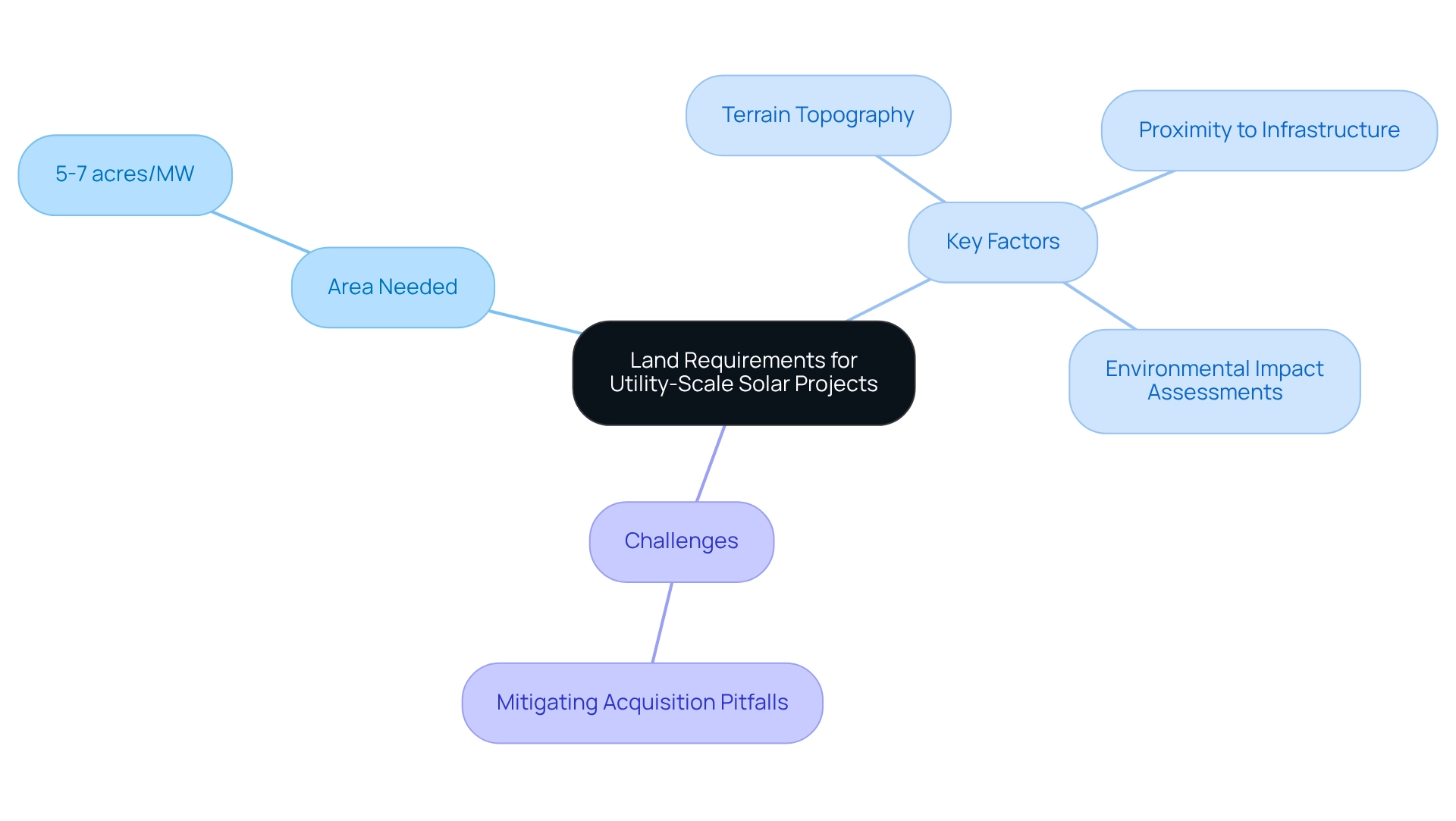
Evaluating Economic Impacts of Land Conversion for Solar Energy
Transforming agricultural or undeveloped areas for utility-scale solar land modeling initiatives presents significant economic consequences. This conversion can notably increase local tax revenues and generate jobs during the construction phase. Studies indicate that renewable energy project construction can create thousands of jobs per project. Efficient policies, such as the state-based Best Management Practices (BMPs) recommended by the USDA, are essential to reconcile agricultural productivity with renewable resource development. These practices ensure sustainable usage without jeopardizing food security.
Moreover, the Czech Republic's power policy highlights the challenges associated with brownfield redevelopment for renewable sources. This underscores the necessity for systematic financial incentives to facilitate such transitions. Developers are encouraged to conduct comprehensive economic impact assessments to evaluate both the benefits and drawbacks of property conversion. This approach aligns the shift to renewable resources with community interests and fosters long-term economic sustainability through utility-scale solar land modeling. As the landscape of power generation evolves, continuous assessment of usage policies becomes crucial. This is vital to adapt to the challenges posed by climate change and to optimize the economic potential of sunlight-based power.
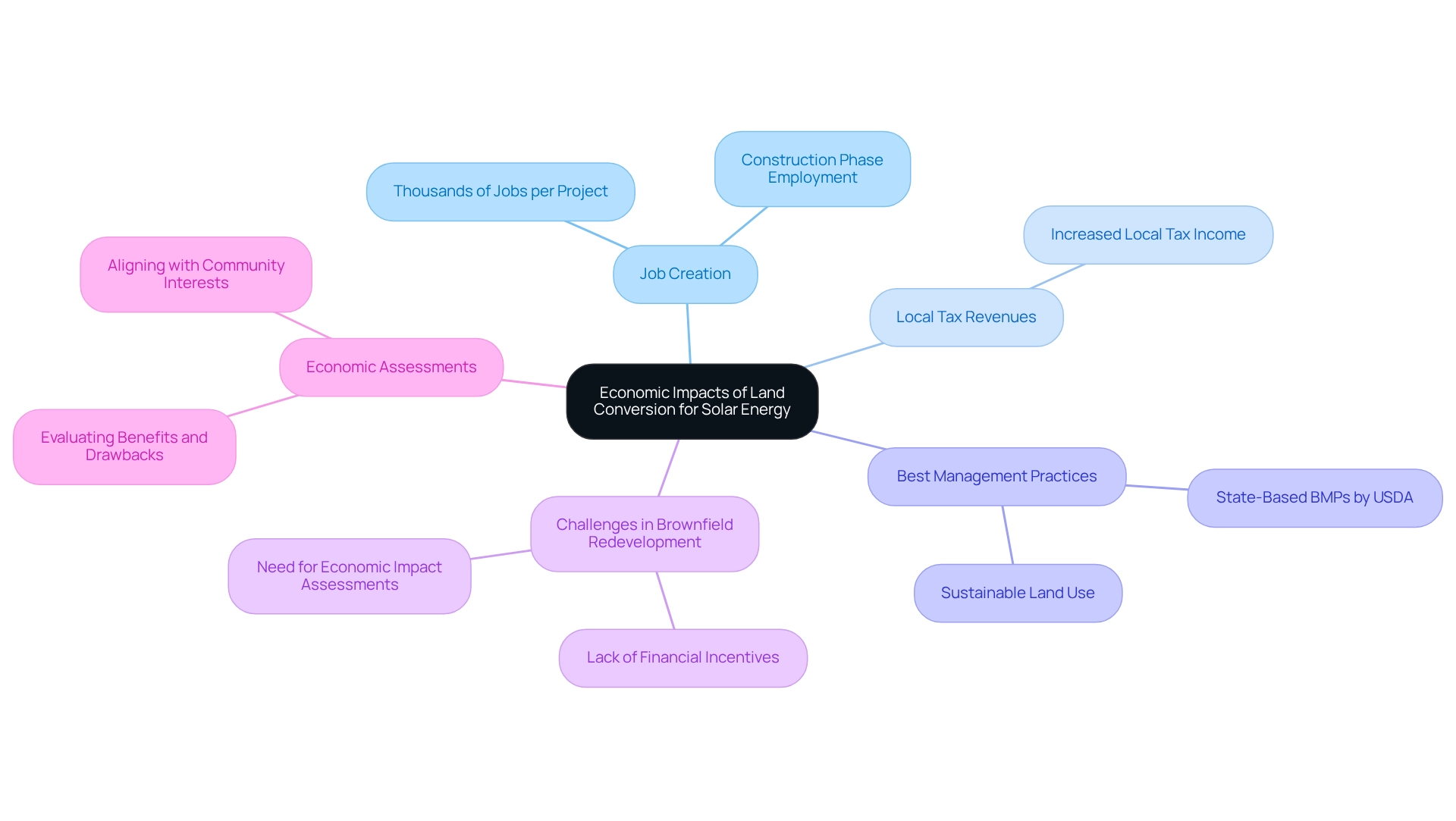
Navigating Regulatory Challenges in Utility-Scale Solar Land Use
Utility-scale solar initiatives face a complex network of federal, state, and local regulations, encompassing zoning laws, environmental impact assessments, and permitting processes. Engaging with regulatory bodies early in the planning phase is essential for developers to identify potential hurdles and streamline the approval process. Local government representatives have expressed concerns that new power legislation may undermine local decision-making authority regarding land use. However, recent modifications to laws indicate a willingness to respect local governance while addressing energy development needs, suggesting a path forward for collaboration.
Effective communication with local stakeholders is crucial, as it significantly reduces the likelihood of delays and fosters community support. In 2025, compliance rates for renewable energy permits remain a vital metric; successful initiatives often showcase robust engagement strategies. Recent data reveals that compliance rates have improved to 85%, highlighting the effectiveness of proactive stakeholder engagement. Industry experts assert that comprehending zoning laws and navigating the permitting landscape are essential for achieving regulatory compliance. Dan Gearino notes that while Minnesota leads the nation in subscription-based energy, challenges remain, particularly concerning costs and local governance. By leveraging insights from successful case studies, including recent local government issues surrounding energy legislation, developers can more effectively navigate the regulatory hurdles inherent in utility-scale solar land modeling, ensuring timely and efficient execution of renewable energy projects. Furthermore, the recent failure of the Manchin-Barrasso Energy Permitting Reform Act of 2024 underscores the ongoing complexities within the regulatory landscape, emphasizing the necessity for developers to remain informed and adaptable. By concentrating on actionable strategies for zoning and permitting, developers can enhance their prospects for success in this evolving sector.
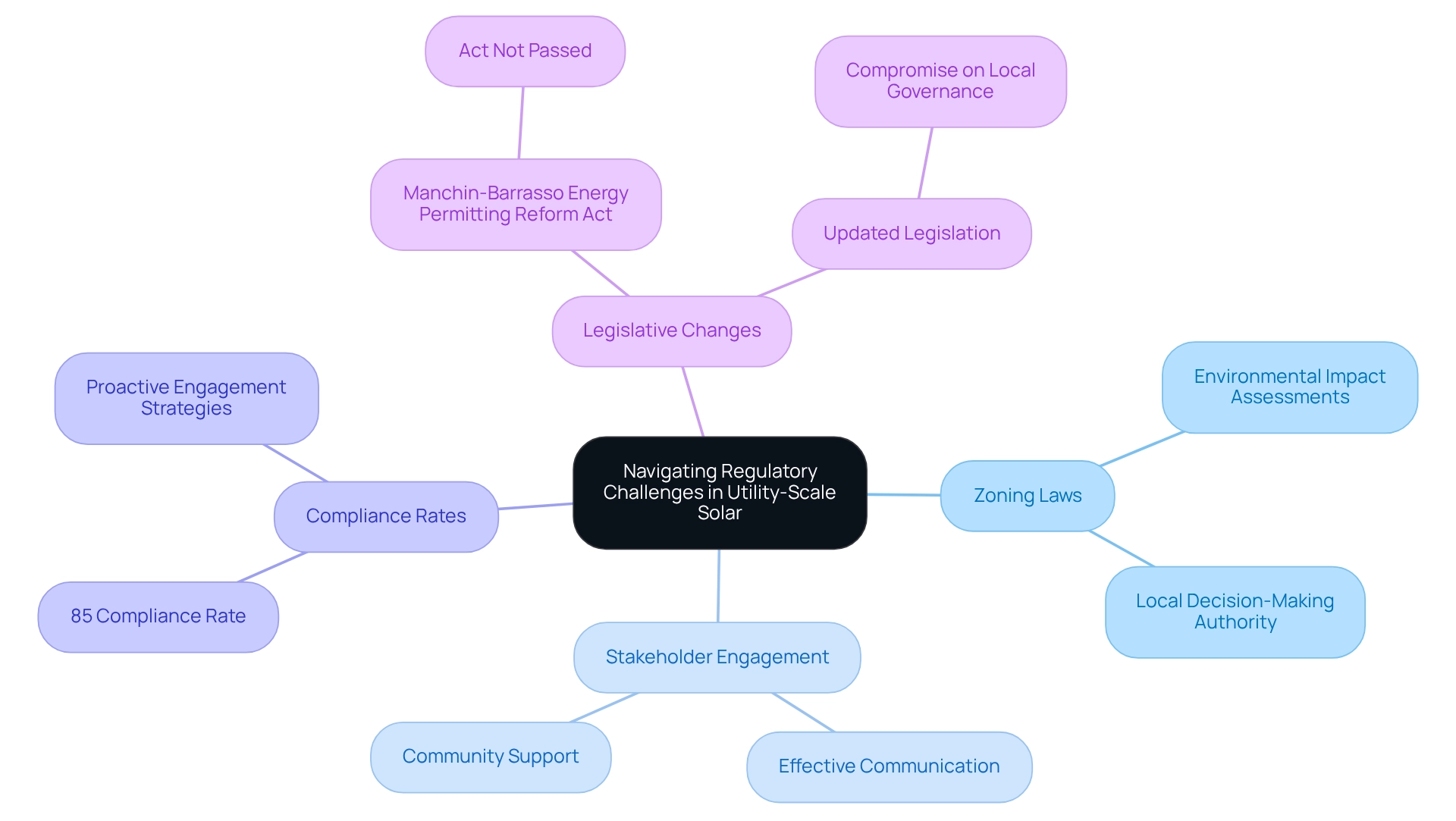
Optimizing Site Selection for Utility-Scale Solar Efficiency
Selecting the optimal location for utility-scale solar land modeling requires a thorough analysis of critical factors such as sunlight exposure, terrain slope, and proximity to existing electrical infrastructure. Developers must utilize GIS mapping tools for utility-scale solar land modeling to evaluate potential sites and pinpoint areas with the highest energy potential. Key criteria for site selection in utility-scale solar land modeling include:
- Sunlight exposure
- Economic performance indicators
- Carbon emission reductions
- Policy support
- Local climate conditions
- Land use patterns
These elements collectively contribute to maximizing power generation while minimizing environmental impacts.
For instance, studies have demonstrated that regions with abundant sunlight, such as those investigated in Iraq, exhibit significant potential for renewable resource development. The GIS-MCDA-AHP framework employed in the Iraq research adeptly addresses climate-related challenges, underscoring the necessity of a systematic approach to site selection. As noted by Omer Al-Dulaimi, in provinces like Muthanna and Wasit, the suitability scores for photovoltaic systems remained high even when varying weights were applied, illustrating the robustness of the criteria utilized in utility-scale solar land modeling. A strategically chosen location, as determined by utility-scale solar land modeling, not only enhances the overall efficiency of the initiative but also improves its return on investment, making it a crucial factor in the success of energy projects. To optimize site selection, developers should prioritize these criteria and harness advanced GIS tools to facilitate informed decision-making.
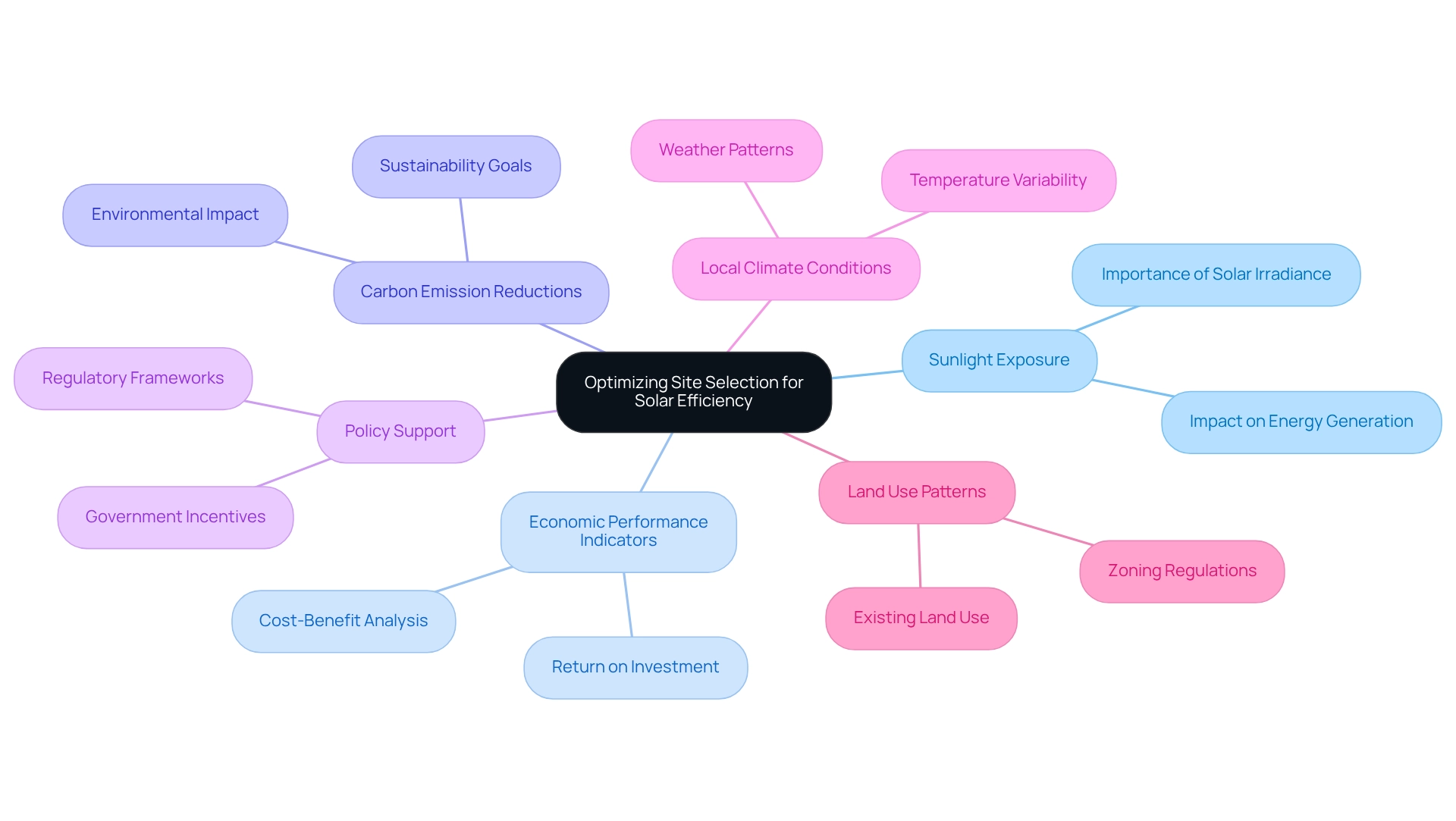
Incorporating Environmental Considerations in Solar Land Modeling
Environmental considerations are paramount in the planning and development of utility-scale solar land modeling for renewable energy projects. As we are the first generation to feel the impact of climate change and the last generation capable of effecting change, comprehensive environmental impact assessments (EIAs) are essential for evaluating potential effects on local ecosystems, wildlife habitats, and water resources.
In 2025, the emphasis on sustainability has intensified, with developers increasingly implementing strategies such as:
- Habitat preservation
- Pollinator-friendly landscaping
- Dual-use energy applications like agrivoltaics
These approaches not only mitigate negative impacts but also enhance biodiversity, fostering a more resilient ecosystem. Successful case studies illustrate that utility-scale solar land modeling, which combines photovoltaic systems with agricultural methods, can lead to improved terrain usage efficiency while supporting local wildlife.
Sustainability is about creating a better world for all, not just for a few. By prioritizing environmental stewardship, developers can cultivate community support and ensure compliance with regulatory requirements, ultimately contributing to a sustainable future.
As Franklin D. Roosevelt aptly noted, 'A nation that destroys its soils destroys itself,' highlighting the necessity of protecting our natural resources in the face of climate change. Furthermore, as Paul Watson emphasizes, conservation is vital in our efforts to align renewable energy use with environmental protection.
Leveraging Advanced Technologies for Effective Solar Land Modeling
Advanced technologies, particularly AI-powered modeling software and GIS tools, are indispensable for utility-scale solar land modeling and optimizing solar land use. These innovations empower developers to analyze extensive datasets, evaluate site suitability, and accurately forecast power output. By leveraging these tools, teams can make data-driven decisions that significantly boost feasibility and operational efficiency.
Furthermore, real-time monitoring systems offer continuous insights into project performance, facilitating timely adjustments that enhance power generation. The rapid growth of photovoltaic energy in the U.S., marked by an impressive 25% year-on-year increase, underscores the crucial role these technologies play in meeting the escalating demand for clean electricity.
With federal policies and incentives, such as the Solar Investment Tax Credit, continuing to bolster photovoltaic installations, the integration of advanced technologies will be vital in propelling the industry forward. Notably, it is estimated that supplying energy for the entire United States could be achieved with just 150 to 200 square kilometers of photovoltaic panels, which underscores the importance of utility-scale solar land modeling in harnessing this potential.
As Elon Musk stated, "Photovoltaic panels endure approximately 30 years, which indicates one setup can supply carbon-free power for decades," emphasizing the long-term benefits of photovoltaic installations.
The case study titled "The Growth of Solar Power in the United States" exemplifies this trend, revealing a consistent 25% year-on-year growth attributed to federal policies, declining installation costs, and increasing demand for clean electricity, marking a significant transition towards renewable sources.
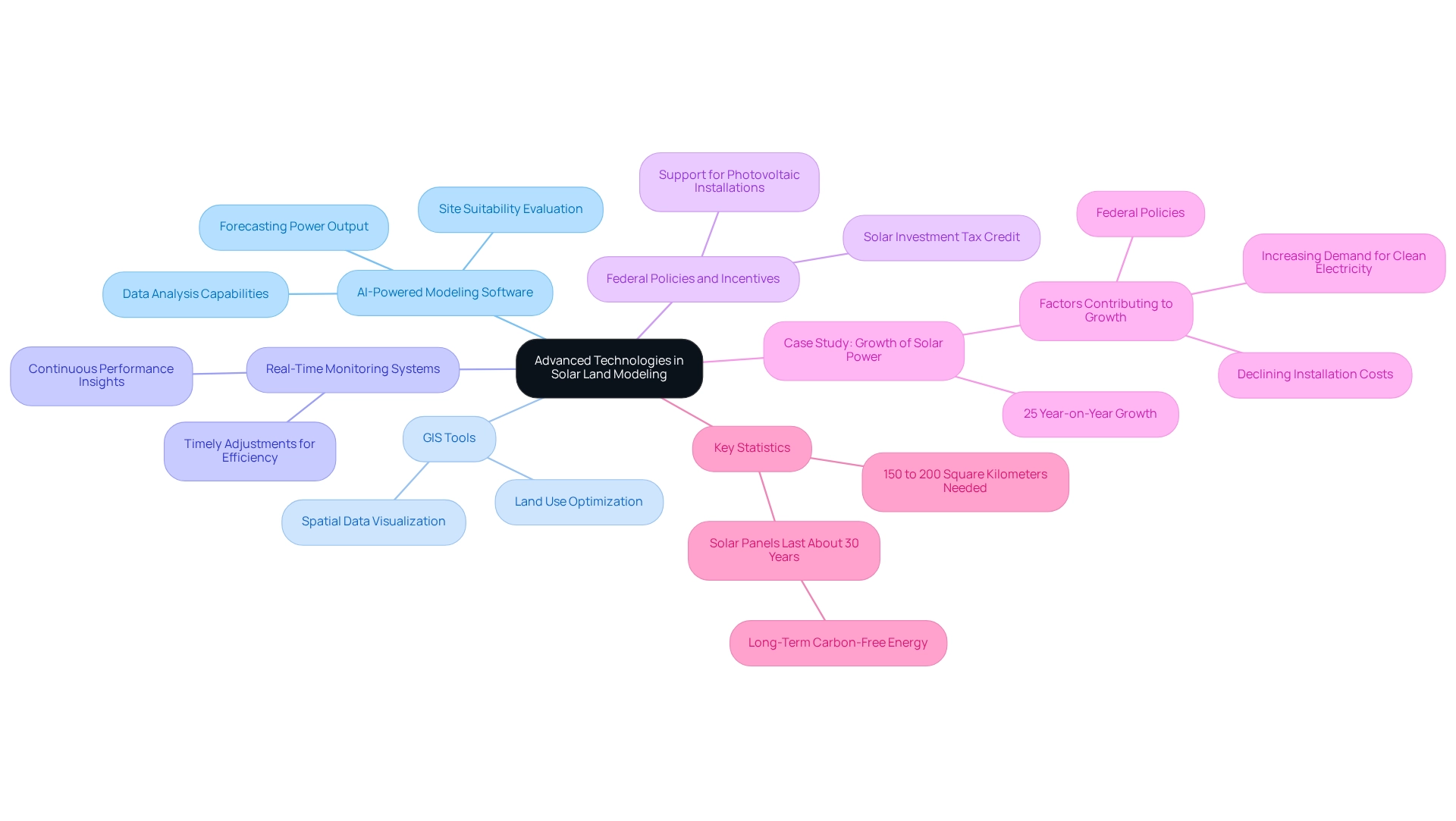
Engaging Communities in Utility-Scale Solar Land Acquisition
Effective community involvement is crucial for the successful acquisition of land in utility-scale solar land modeling for renewable energy initiatives. Developers must prioritize proactive communication with local residents, addressing their concerns while clearly articulating the advantages of renewable energy. Strategies such as:
- Hosting public meetings
- Conducting surveys
- Partnering with local organizations
can significantly enhance trust and foster a sense of ownership among community members. A recent survey of 123 professionals from 62 firms indicates that most developers prefer public input while maintaining decision-making authority, suggesting a balanced strategy for citizen involvement.
By actively engaging stakeholders in the planning phase, developers can enhance acceptance and decrease resistance. As of June 2024, approximately 7.87 GW of community energy is operational in the U.S., with a strong emphasis on serving low- to moderate-income households, particularly in states such as Florida, New York, Massachusetts, and Minnesota. This aligns with state mandates requiring a percentage of community energy projects to be subscribed by low-income participants, reflecting a commitment to inclusivity, as 20 out of 24 states and localities have established provisions for this.
Successful outreach strategies not only build trust but also demonstrate the tangible benefits of energy projects. For instance, a proposed community energy initiative in Arizona is expected to contribute around $4.8 billion to the state’s GDP and create over 50,000 job years of employment over 35 years. Such statistics underscore the positive impact of renewable energy on local economies, reinforcing the importance of community involvement in property acquisition efforts. Furthermore, the Department of Energy's analysis reveals that community energy subscriptions have a median capacity-weighted net present value (NPV) of approximately +$0.27 per watt (W-AC), indicating that subscribers save money throughout their subscription compared to opting out.
Managing Long-Term Land Use for Utility-Scale Solar Projects
Long-term site management is essential for ensuring the sustainability of utility-scale solar land modeling projects. Developers must implement practices that enhance soil health, manage vegetation effectively, and protect local wildlife habitats. Regular maintenance and monitoring are vital for the early identification of potential issues, guaranteeing that the solar installation operates at peak efficiency.
Establishing collaborations with local conservation groups significantly bolsters stewardship initiatives, supporting the ecological integrity of the region. Sustainable usage methods not only promote the durability of initiatives but also align with the increasing investor focus on sustainability. This shift is recognized as a crucial factor for economic development and job creation in the renewable sector. As Tom Steyer, Founder of NextGen America, asserts, "Renewable resources are a clear winner when it comes to boosting the economy and creating jobs."
Moreover, it is noteworthy that utility-scale solar land modeling indicates that approximately 150 to 200 square kilometers of photovoltaic panels could provide energy for the entire United States, underscoring the vast potential of renewable energy projects and the critical role of effective land management. The challenges faced in renewable energy development highlight the urgent need for ongoing investment in this technology and infrastructure to fully realize its potential.
Future Trends in Utility-Scale Solar Land Modeling
The future of utility-scale solar land modeling is set to witness remarkable advancements, primarily fueled by technological innovations and evolving regulatory frameworks. A pivotal trend is the increasing integration of AI and machine learning, which enhance predictive modeling capabilities, facilitating more accurate site evaluations and planning. Additionally, the advancement of GIS technologies is crucial for site analysis, empowering developers to make informed decisions grounded in comprehensive data insights. As the renewable energy sector anticipates a 4% compound annual growth rate, this growth underscores the necessity for utility-scale solar land modeling to optimize space utilization and planning. Furthermore, the International Energy Agency projects that solar PV will represent 4.5% of total global electricity generation by 2025, emphasizing the escalating significance of solar energy on the global stage. There is also an intensified focus on sustainable usage practices that align with environmental stewardship.
Moreover, community engagement is becoming increasingly essential; developers are urged to adopt transparent and inclusive land acquisition strategies that prioritize local interests. This comprehensive approach not only cultivates trust but also ensures that energy projects yield positive contributions to the communities they serve, reflecting a broader commitment to responsible development within the renewable energy sector. As Inemesit Ukpanah articulates, grasping these trends is vital for stakeholders in the solar industry to adeptly navigate the evolving landscape.
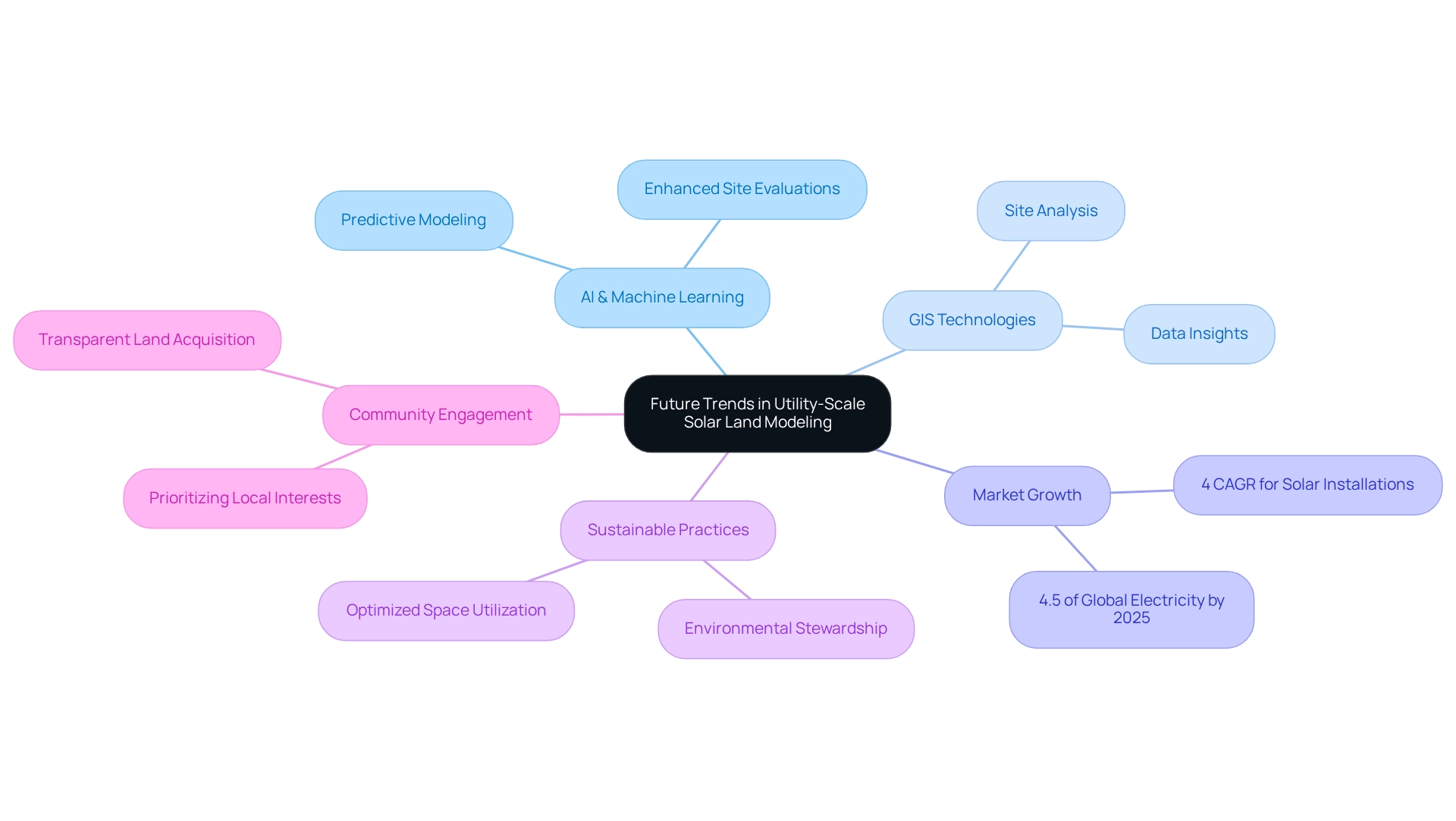
Conclusion
Utility-scale solar projects present a remarkable opportunity for advancing sustainable energy; however, their success hinges on a comprehensive understanding of key factors. Careful land selection is paramount to fulfill operational and regulatory requirements, while the economic impacts of land conversion can lead to job creation and increased local tax revenues, provided that sustainable practices are upheld to safeguard food security.
Developers encounter a complex regulatory landscape, making early engagement with local stakeholders essential to streamline approvals and cultivate community support. Effective communication can significantly mitigate project delays and enhance compliance rates. Furthermore, leveraging advanced technologies such as AI-powered modeling and GIS tools is critical for optimizing site selection and improving project feasibility through informed decision-making.
Prioritizing environmental considerations is vital, with a strong emphasis on sustainability in solar land modeling to protect biodiversity and ensure adherence to regulations. Community engagement strategies are equally crucial, as they foster trust and illuminate the benefits of solar initiatives for local residents.
As the solar sector continues to evolve, embracing trends in technology, sustainability, and community involvement will be indispensable. Stakeholders must remain adaptable and utilize advanced tools while promoting inclusive practices to adeptly navigate the complexities of solar land acquisition. A collective commitment to responsible development and environmental stewardship will ultimately shape the future of solar energy, steering the industry toward a more sustainable and economically beneficial trajectory.
Frequently Asked Questions
What challenges does Harbinger Land address in the renewable energy sector?
Harbinger Land addresses critical challenges of land acquisition, particularly through utility-scale solar land modeling, which involves navigating legal and regulatory hurdles.
What services does Harbinger Land offer for land acquisition?
Harbinger Land provides tailored solutions that include site and right-of-way acquisition, advanced title research powered by AI, GIS mapping, and efficient data processing.
How does utility-scale solar land modeling benefit developers and municipalities?
Utility-scale solar land modeling streamlines the negotiation and acquisition of leases and easements necessary for distributed energy resource (DER) and infrastructure development, saving clients time and reducing costs.
What technology does Harbinger Land utilize for data processing?
Harbinger Land employs advanced data processing capabilities driven by Optical Character Recognition (OCR) and machine learning to rapidly identify key information that impacts leasing and development operations.
Why is meticulous planning and site selection important for photovoltaic initiatives?
Photovoltaic initiatives require 5 to 7 acres of area per megawatt (MW) of production capacity, making it essential to ensure that locations adhere to operational and regulatory standards, including factors like terrain topography and environmental impact.
What economic impacts can arise from transforming agricultural or undeveloped areas for solar projects?
Transforming these areas can increase local tax revenues and generate jobs during construction, with studies showing that renewable energy project construction can create thousands of jobs per project.
What policies are recommended to reconcile agricultural productivity with renewable resource development?
The state-based Best Management Practices (BMPs) recommended by the USDA are essential for ensuring sustainable usage without jeopardizing food security.
What role do financial incentives play in renewable energy projects?
Systematic financial incentives are necessary to facilitate transitions, such as brownfield redevelopment for renewable sources, and developers are encouraged to conduct comprehensive economic impact assessments to evaluate the benefits and drawbacks of property conversion.
List of Sources
- Evaluating Economic Impacts of Land Conversion for Solar Energy
- (PDF) From Wasted Land to Megawatts: How to Convert Brownfields Into Solar Power Plants (the Case of the Czech Republic) (https://researchgate.net/publication/269911382_From_Wasted_Land_to_Megawatts_How_to_Convert_Brownfields_Into_Solar_Power_Plants_the_Case_of_the_Czech_Republic)
- Economic Implications of Agricultural Land Conversion to Solar Power Production (https://mdpi.com/1996-1073/14/19/6063)
- rff.org (https://rff.org/publications/reports/converting-forests-to-solar-facilities-causes-potential-and-implications)
- Navigating Regulatory Challenges in Utility-Scale Solar Land Use
- Virginia Debate Over Solar Development Goals and Land Use Has Rural Lawmakers on Edge - Inside Climate News (https://insideclimatenews.org/news/30012025/virginia-solar-development-debate)
- The policy, federal actions and judicial decisions shaping solar in 2025 (https://solarpowerworldonline.com/2025/01/the-policy-federal-actions-and-judicial-decisions-shaping-solar-in-2025)
- Top Solar Quotes (https://inventionsolar.com/solar-quotes)
- Optimizing Site Selection for Utility-Scale Solar Efficiency
- sciencedirect.com (https://sciencedirect.com/science/article/pii/S2666519025000585)
- Evaluation of criteria for site selection of solar photovoltaic (PV) projects using fuzzy logarithmic additive estimation of weight coefficients (https://sciencedirect.com/science/article/pii/S2352484721011239)
- Incorporating Environmental Considerations in Solar Land Modeling
- 100 Quotes About Sustainability and ESG [2025] (https://digitaldefynd.com/IQ/inspirational-quotes-about-sustainability)
- The Best Environmental Quotes (https://environmentshow.com/best-environmental-quotes)
- Leveraging Advanced Technologies for Effective Solar Land Modeling
- Top 10 Inspiring Quotes About Solar Energy - Solar academy (https://solar-academy.com/top-10-inspiring-quotes-about-solar-energy)
- Quotes About Solar Power: 50 Picks to Light Up Your Life - Lumify Energy (https://lumifyenergy.com/blog/quotes-about-solar-power)
- Engaging Communities in Utility-Scale Solar Land Acquisition
- sciencedirect.com (https://sciencedirect.com/science/article/pii/S2214629624002974)
- arcadia.com (https://arcadia.com/blog/community-solar-statistics)
- Community Solar Market Trends (https://energy.gov/communitysolar/community-solar-market-trends)
- Managing Long-Term Land Use for Utility-Scale Solar Projects
- Quotes About Solar Power: 50 Picks to Light Up Your Life - Lumify Energy (https://lumifyenergy.com/blog/quotes-about-solar-power)
- 100+ inspirational and powerful quotes on Sustainability (clustered by topic) - Twenty Now (https://twentynow.com/sustainability-initiatives/sustainability/100-inspirational-and-powerful-quotes-on-sustainability-clustered-by-topic)
- Future Trends in Utility-Scale Solar Land Modeling
- U.S Solar Market Growth Predictions for 2025 | Texas Solar Energy Society (https://txses.org/u-s-solar-market-growth-predictions-for-2025)
- Solar Panel Statistics, Facts, and Trends of 2025 (https://greenmatch.co.uk/solar-energy/solar-pv-statistics)
- Utility-Scale Solar, 2023 Edition: Empirical Trends in Deployment, Technology, Cost, Performance, PPA Pricing, and Value in the United States | Energy Markets & Policy (https://emp.lbl.gov/publications/utility-scale-solar-2023-edition)




